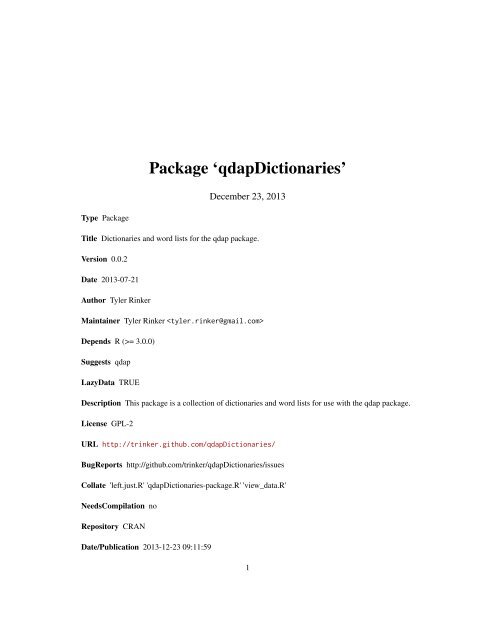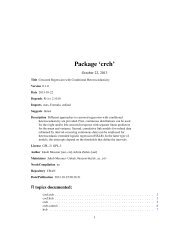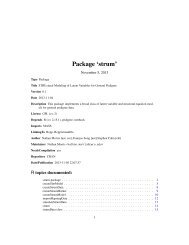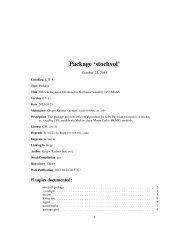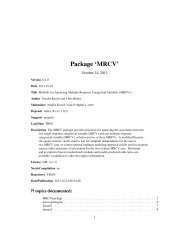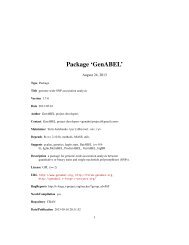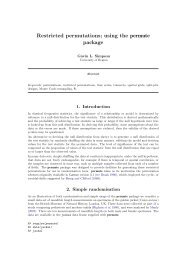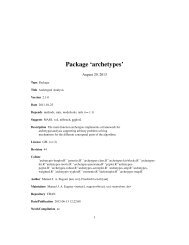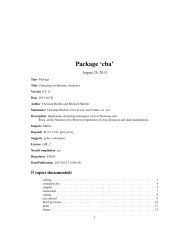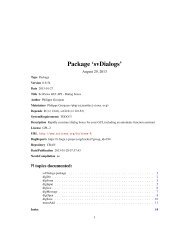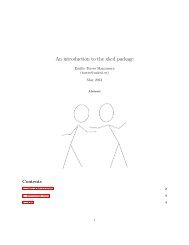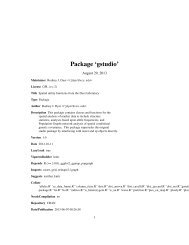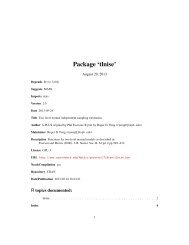Package 'qdapDictionaries' - The Comprehensive R Archive Network
Package 'qdapDictionaries' - The Comprehensive R Archive Network
Package 'qdapDictionaries' - The Comprehensive R Archive Network
You also want an ePaper? Increase the reach of your titles
YUMPU automatically turns print PDFs into web optimized ePapers that Google loves.
<strong>Package</strong> ‘qdapDictionaries’<br />
December 23, 2013<br />
Type <strong>Package</strong><br />
Title Dictionaries and word lists for the qdap package.<br />
Version 0.0.2<br />
Date 2013-07-21<br />
Author Tyler Rinker<br />
Maintainer Tyler Rinker <br />
Depends R (>= 3.0.0)<br />
Suggests qdap<br />
LazyData TRUE<br />
Description This package is a collection of dictionaries and word lists for use with the qdap package.<br />
License GPL-2<br />
URL http://trinker.github.com/qdapDictionaries/<br />
BugReports http://github.com/trinker/qdapDictionaries/issues<br />
Collate 'left.just.R' 'qdapDictionaries-package.R' 'view_data.R'<br />
NeedsCompilation no<br />
Repository CRAN<br />
Date/Publication 2013-12-23 09:11:59<br />
1
2 abbreviations<br />
R topics documented:<br />
abbreviations . . . . . . . . . . . . . . . . . . . . . . . . . . . . . . . . . . . . . . . . 2<br />
action.verbs . . . . . . . . . . . . . . . . . . . . . . . . . . . . . . . . . . . . . . . . . 3<br />
adverb . . . . . . . . . . . . . . . . . . . . . . . . . . . . . . . . . . . . . . . . . . . . 3<br />
amplification.words . . . . . . . . . . . . . . . . . . . . . . . . . . . . . . . . . . . . . 4<br />
BuckleySaltonSWL . . . . . . . . . . . . . . . . . . . . . . . . . . . . . . . . . . . . . 4<br />
contractions . . . . . . . . . . . . . . . . . . . . . . . . . . . . . . . . . . . . . . . . . 5<br />
deamplification.words . . . . . . . . . . . . . . . . . . . . . . . . . . . . . . . . . . . . 5<br />
DICTIONARY . . . . . . . . . . . . . . . . . . . . . . . . . . . . . . . . . . . . . . . 6<br />
emoticon . . . . . . . . . . . . . . . . . . . . . . . . . . . . . . . . . . . . . . . . . . 6<br />
env.pol . . . . . . . . . . . . . . . . . . . . . . . . . . . . . . . . . . . . . . . . . . . . 7<br />
env.syl . . . . . . . . . . . . . . . . . . . . . . . . . . . . . . . . . . . . . . . . . . . . 7<br />
env.syn . . . . . . . . . . . . . . . . . . . . . . . . . . . . . . . . . . . . . . . . . . . 8<br />
interjections . . . . . . . . . . . . . . . . . . . . . . . . . . . . . . . . . . . . . . . . . 8<br />
labMT . . . . . . . . . . . . . . . . . . . . . . . . . . . . . . . . . . . . . . . . . . . . 8<br />
NAMES . . . . . . . . . . . . . . . . . . . . . . . . . . . . . . . . . . . . . . . . . . . 9<br />
NAMES_LIST . . . . . . . . . . . . . . . . . . . . . . . . . . . . . . . . . . . . . . . 10<br />
NAMES_SEX . . . . . . . . . . . . . . . . . . . . . . . . . . . . . . . . . . . . . . . . 10<br />
negation.words . . . . . . . . . . . . . . . . . . . . . . . . . . . . . . . . . . . . . . . 11<br />
negative.words . . . . . . . . . . . . . . . . . . . . . . . . . . . . . . . . . . . . . . . 11<br />
OnixTxtRetToolkitSWL1 . . . . . . . . . . . . . . . . . . . . . . . . . . . . . . . . . . 12<br />
positive.words . . . . . . . . . . . . . . . . . . . . . . . . . . . . . . . . . . . . . . . . 12<br />
preposition . . . . . . . . . . . . . . . . . . . . . . . . . . . . . . . . . . . . . . . . . 13<br />
print.view_data . . . . . . . . . . . . . . . . . . . . . . . . . . . . . . . . . . . . . . . 13<br />
qdapDictionaries . . . . . . . . . . . . . . . . . . . . . . . . . . . . . . . . . . . . . . 13<br />
SYNONYM . . . . . . . . . . . . . . . . . . . . . . . . . . . . . . . . . . . . . . . . . 14<br />
Top100Words . . . . . . . . . . . . . . . . . . . . . . . . . . . . . . . . . . . . . . . . 14<br />
Top200Words . . . . . . . . . . . . . . . . . . . . . . . . . . . . . . . . . . . . . . . . 15<br />
Top25Words . . . . . . . . . . . . . . . . . . . . . . . . . . . . . . . . . . . . . . . . . 15<br />
view_data . . . . . . . . . . . . . . . . . . . . . . . . . . . . . . . . . . . . . . . . . . 16<br />
Index 17<br />
abbreviations<br />
Small Abbreviations Data Set<br />
Description<br />
Format<br />
Details<br />
A dataset containing abbreviations and their qdap friendly form.<br />
A data frame with 14 rows and 2 variables<br />
• abv. Common transcript abbreviations<br />
• rep. qdap representation of those abbreviations
action.verbs 3<br />
action.verbs<br />
Action Word List<br />
Description<br />
Format<br />
Details<br />
A dataset containing a vector of action words. This is a subset of the Moby project: Moby Part-of-<br />
Speech.<br />
A vector with 1569 elements<br />
From Grady Ward’s Moby project: "This second edition is a particularly thorough revision of the<br />
original Moby Part-of-Speech. Beyond the fifteen thousand new entries, many thousand more entries<br />
have been scrutinized for correctness and modernity. This is unquestionably the largest P-O-S<br />
list in the world. Note that the many included phrases means that parsing algorithms can now<br />
tokenize in units larger than a single word, increasing both speed and accuracy."<br />
References<br />
http://icon.shef.ac.uk/Moby/mpos.html<br />
adverb<br />
Adverb Word List<br />
Description<br />
Format<br />
Details<br />
A dataset containing a vector of adverbs words. This is a subset of the Moby project: Moby Partof-Speech.<br />
A vector with 13398 elements<br />
From Grady Ward’s Moby project: "This second edition is a particularly thorough revision of the<br />
original Moby Part-of-Speech. Beyond the fifteen thousand new entries, many thousand more entries<br />
have been scrutinized for correctness and modernity. This is unquestionably the largest P-O-S<br />
list in the world. Note that the many included phrases means that parsing algorithms can now<br />
tokenize in units larger than a single word, increasing both speed and accuracy."<br />
References<br />
http://icon.shef.ac.uk/Moby/mpos.html
4 BuckleySaltonSWL<br />
amplification.words<br />
Amplifying Words<br />
Description<br />
Format<br />
Details<br />
A dataset containing a vector of words that amplify word meaning.<br />
A vector with 49 elements<br />
Valence shifters are words that alter or intensify the meaning of the polarized words and include<br />
negators and amplifiers. Negators are, generally, adverbs that negate sentence meaning; for example<br />
the word like in the sentence, "I do like pie.", is given the opposite meaning in the sentence, "I do<br />
not like pie.", now containing the negator not. Amplifiers are, generally, adverbs or adjectives that<br />
intensify sentence meaning. Using our previous example, the sentiment of the negator altered sentence,<br />
"I seriously do not like pie.", is heightened with addition of the amplifier seriously. Whereas<br />
de-amplifiers decrease the intensity of a polarized word as in the sentence "I barely like pie"; the<br />
word "barely" deamplifies the word like.<br />
BuckleySaltonSWL<br />
Buckley & Salton Stopword List<br />
Description<br />
Format<br />
Details<br />
Note<br />
A stopword list containing a character vector of stopwords.<br />
A character vector with 546 elements<br />
From Onix Text Retrieval Toolkit API Reference: "This stopword list was built by Gerard Salton<br />
and Chris Buckley for the experimental SMART information retrieval system at Cornell University.<br />
This stopword list is generally considered to be on the larger side and so when it is used, some<br />
implementations edit it so that it is better suited for a given domain and audience while others use<br />
this stopword list as it stands."<br />
Reduced from the original 571 words to 546.<br />
References<br />
http://www.lextek.com/manuals/onix/stopwords2.html
contractions 5<br />
contractions<br />
Contraction Conversions<br />
Description<br />
A dataset containing common contractions and their expanded form.<br />
Format<br />
A data frame with 66 rows and 2 variables<br />
Details<br />
• contraction. <strong>The</strong> contraction word.<br />
• expanded. <strong>The</strong> expanded form of the contraction.<br />
deamplification.words<br />
De-amplifying Words<br />
Description<br />
A dataset containing a vector of words that de-amplify word meaning.<br />
Format<br />
A vector with 13 elements<br />
Details<br />
Valence shifters are words that alter or intensify the meaning of the polarized words and include<br />
negators and amplifiers. Negators are, generally, adverbs that negate sentence meaning; for example<br />
the word like in the sentence, "I do like pie.", is given the opposite meaning in the sentence, "I do<br />
not like pie.", now containing the negator not. Amplifiers are, generally, adverbs or adjectives that<br />
intensify sentence meaning. Using our previous example, the sentiment of the negator altered sentence,<br />
"I seriously do not like pie.", is heightened with addition of the amplifier seriously. Whereas<br />
de-amplifiers decrease the intensity of a polarized word as in the sentence "I barely like pie"; the<br />
word "barely" deamplifies the word like.
6 emoticon<br />
DICTIONARY<br />
Nettalk Corpus Syllable Data Set<br />
Description<br />
Format<br />
Details<br />
Note<br />
A dataset containing syllable counts.<br />
A data frame with 20137 rows and 2 variables<br />
• word. <strong>The</strong> word<br />
• syllables. Number of syllables<br />
This data set is based on the Nettalk Corpus but has some researcher word deletions and additions<br />
based on the needs of the syllable_sum algorithm.<br />
References<br />
Sejnowski, T.J., and Rosenberg, C.R. (1987). "Parallel networks that learn to pronounce English<br />
text" in Complex Systems, 1, 145-168. Retrieved from: http://archive.ics.uci.edu/<br />
ml/datasets/Connectionist+Bench+(Nettalk+Corpus)<br />
UCI Machine Learning Repository website<br />
emoticon<br />
Emoticons Data Set<br />
Description<br />
A dataset containing common emoticons (adapted from Popular Emoticon List).<br />
Format<br />
A data frame with 81 rows and 2 variables<br />
Details<br />
• meaning. <strong>The</strong> meaning of the emoticon<br />
• emoticon. <strong>The</strong> graphic representation of the emoticon<br />
References<br />
http://www.lingo2word.com/lists/emoticon_listH.html
env.pol 7<br />
env.pol<br />
Polarity Lookup Environment<br />
Description<br />
A dataset containing a polarity lookup environment (see polarity).<br />
Format<br />
A environment with words and corresponding values.<br />
References<br />
Hu, M., & Liu, B. (2004). Mining opinion features in customer reviews. National Conference on<br />
Artificial Intelligence.<br />
http://www.cs.uic.edu/~liub/FBS/sentiment-analysis.html<br />
env.syl<br />
Syllable Lookup Environment<br />
Description<br />
A dataset containing a syllable lookup environment (see DICTIONARY).<br />
Format<br />
A environment with the DICTIONARY data set.<br />
Details<br />
For internal use.<br />
References<br />
UCI Machine Learning Repository website
8 labMT<br />
env.syn<br />
Synonym Lookup Environment<br />
Description<br />
A dataset containing a synonym lookup environment (see SYNONYM).<br />
Format<br />
A environment with words and synonyms.<br />
References<br />
Scraped from: Reverso Online Dictionary. <strong>The</strong> word list fed to Reverso is the unique words from<br />
the combination of DICTIONARY and labMT.<br />
interjections<br />
Interjections<br />
Description<br />
A dataset containing a character vector of common interjections.<br />
Format<br />
A character vector with 139 elements<br />
References<br />
http://www.vidarholen.net/contents/interjections/<br />
labMT<br />
Language Assessment by Mechanical Turk (labMT) Sentiment Words<br />
Description<br />
A dataset containing words, average happiness score (polarity), standard deviations, and rankings.<br />
Format<br />
A data frame with 10222 rows and 8 variables
NAMES 9<br />
Details<br />
References<br />
• word. <strong>The</strong> word.<br />
• happiness_rank. Happiness ranking of words based on average happiness scores.<br />
• happiness_average. Average happiness score.<br />
• happiness_standard_deviation. Standard deviations of the happiness scores.<br />
• twitter_rank. Twitter ranking of the word.<br />
• google_rank. Google ranking of the word.<br />
• nyt_rank. New York Times ranking of the word.<br />
• lyrics_rank. lyrics ranking of the word.<br />
Dodds, P.S., Harris, K.D., Kloumann, I.M., Bliss, C.A., & Danforth, C.M. (2011) Temporal patterns<br />
of happiness and information in a global social network: Hedonometrics and twitter. PLoS ONE<br />
6(12): e26752. doi:10.1371/journal.pone.0026752<br />
http://www.plosone.org/article/fetchSingleRepresentation.action?uri=info:doi/10.<br />
1371/journal.pone.0026752.s001<br />
NAMES<br />
First Names and Gender (U.S.)<br />
Description<br />
A dataset containing 1990 U.S. census data on first names.<br />
Format<br />
A data frame with 5494 rows and 7 variables<br />
Details<br />
References<br />
• name. A first name.<br />
• per.freq. Frequency in percent of the name by gender.<br />
• cum.freq. Cumulative frequency in percent of the name by gender.<br />
• rank. Rank of the name by gender.<br />
• gender. Gender of the combined male/female list (M/F).<br />
• gender2. Gender of the combined male/female list with "B" in place of overlapping (M/F)<br />
names.<br />
• pred.sex. Predicted gender of the names with B’s in gender2 repalced with the gender that<br />
had a higher per.freq.<br />
http://www.census.gov/genealogy/www/data/1990surnames/names_files.html
10 NAMES_SEX<br />
NAMES_LIST<br />
First Names and Predictive Gender (U.S.) List<br />
Description<br />
A list version of the NAMES_SEX dataset broken down by first letter.<br />
Format<br />
A list with 26 elements<br />
Details<br />
Alphabetical list of dataframes with the following variables:<br />
References<br />
• name. A first name.<br />
• gender2. Gender of the combined male/female list with "B" in place of overlapping (M/F)<br />
names.<br />
• pred.sex. Predicted gender of the names with B’s in gender2 repalced with the gender that<br />
had a higher per.freq.<br />
http://www.census.gov/genealogy/www/data/1990surnames/names_files.html<br />
NAMES_SEX<br />
First Names and Predictive Gender (U.S.)<br />
Description<br />
A truncated version of the NAMES dataset used for predicting.<br />
Format<br />
A data frame with 5163 rows and 3 variables<br />
Details<br />
References<br />
• name. A first name.<br />
• gender2. Gender of the combined male/female list with "B" in place of overlapping (M/F)<br />
names.<br />
• pred.sex. Predicted gender of the names with B’s in gender2 repalced with the gender that<br />
had a higher per.freq.<br />
http://www.census.gov/genealogy/www/data/1990surnames/names_files.html
negation.words 11<br />
negation.words<br />
Negating Words<br />
Description<br />
A dataset containing a vector of words that negate word meaning.<br />
Format<br />
A vector with 23 elements<br />
Details<br />
Valence shifters are words that alter or intensify the meaning of the polarized words and include<br />
negators and amplifiers. Negators are, generally, adverbs that negate sentence meaning; for example<br />
the word like in the sentence, "I do like pie.", is given the opposite meaning in the sentence, "I do<br />
not like pie.", now containing the negator not. Amplifiers are, generally, adverbs or adjectives that<br />
intensify sentence meaning. Using our previous example, the sentiment of the negator altered sentence,<br />
"I seriously do not like pie.", is heightened with addition of the amplifier seriously. Whereas<br />
de-amplifiers decrease the intensity of a polarized word as in the sentence "I barely like pie"; the<br />
word "barely" deamplifies the word like.<br />
negative.words<br />
Negative Words<br />
Description<br />
A dataset containing a vector of negative words.<br />
Format<br />
A vector with 4776 elements<br />
Details<br />
A sentence containing more negative words would be deemed a negative sentence, whereas a sentence<br />
containing more positive words would be considered positive.<br />
References<br />
Hu, M., & Liu, B. (2004). Mining opinion features in customer reviews. National Conference on<br />
Artificial Intelligence.<br />
http://www.cs.uic.edu/~liub/FBS/sentiment-analysis.html
12 positive.words<br />
OnixTxtRetToolkitSWL1 Onix Text Retrieval Toolkit Stopword List 1<br />
Description<br />
Format<br />
Details<br />
Note<br />
A stopword list containing a character vector of stopwords.<br />
A character vector with 404 elements<br />
From Onix Text Retrieval Toolkit API Reference: "This stopword list is probably the most widely<br />
used stopword list. It covers a wide number of stopwords without getting too aggressive and including<br />
too many words which a user might search upon."<br />
Reduced from the original 429 words to 404.<br />
References<br />
http://www.lextek.com/manuals/onix/stopwords1.html<br />
positive.words<br />
Positive Words<br />
Description<br />
Format<br />
Details<br />
A dataset containing a vector of positive words.<br />
A vector with 2003 elements<br />
A sentence containing more negative words would be deemed a negative sentence, whereas a sentence<br />
containing more positive words would be considered positive.<br />
References<br />
Hu, M., & Liu, B. (2004). Mining opinion features in customer reviews. National Conference on<br />
Artificial Intelligence.<br />
http://www.cs.uic.edu/~liub/FBS/sentiment-analysis.html
preposition 13<br />
preposition<br />
Preposition Words<br />
Description<br />
A dataset containing a vector of common prepositions.<br />
Format<br />
A vector with 162 elements<br />
print.view_data<br />
Prints a view_data Object<br />
Description<br />
Prints a view_data object.<br />
Usage<br />
## S3 method for class view_data<br />
print(x, ...)<br />
Arguments<br />
x<br />
<strong>The</strong> view_data object.<br />
... ignored<br />
qdapDictionaries<br />
qdapDictionaries<br />
Description<br />
A collection of dictionaries and Word Lists to Accompany the qdap <strong>Package</strong>
14 Top100Words<br />
SYNONYM<br />
Synonyms Data Set<br />
Description<br />
Format<br />
Details<br />
Note<br />
A dataset containing words and possible synonym matches.<br />
A data frame with 11050 rows and 2 variables<br />
• word. <strong>The</strong> look up word.<br />
• match.string. A single string of possible matches.<br />
Intended for internal use with the synonyms function.<br />
References<br />
Scraped from: Reverso Online Dictionary. <strong>The</strong> word list fed to Reverso is the unique words from<br />
the combination of DICTIONARY and labMT.<br />
Top100Words<br />
Fry’s 100 Most Commonly Used English Words<br />
Description<br />
Format<br />
Details<br />
A stopword list containing a character vector of stopwords.<br />
A character vector with 100 elements<br />
Fry’s Word List: <strong>The</strong> first 25 make up about one-third of all printed material in English. <strong>The</strong> first<br />
100 make up about one-half of all printed material in English. <strong>The</strong> first 300 make up about 65% of<br />
all printed material in English."<br />
References<br />
Fry, E. B. (1997). Fry 1000 instant words. Lincolnwood, IL: Contemporary Books.
Top200Words 15<br />
Top200Words<br />
Fry’s 200 Most Commonly Used English Words<br />
Description<br />
A stopword list containing a character vector of stopwords.<br />
Format<br />
A character vector with 200 elements<br />
Details<br />
Fry’s Word List: <strong>The</strong> first 25 make up about one-third of all printed material in English. <strong>The</strong> first<br />
100 make up about one-half of all printed material in English. <strong>The</strong> first 300 make up about 65% of<br />
all printed material in English."<br />
References<br />
Fry, E. B. (1997). Fry 1000 instant words. Lincolnwood, IL: Contemporary Books.<br />
Top25Words<br />
Fry’s 25 Most Commonly Used English Words<br />
Description<br />
A stopword list containing a character vector of stopwords.<br />
Format<br />
A character vector with 25 elements<br />
Details<br />
Fry’s Word List: <strong>The</strong> first 25 make up about one-third of all printed material in English. <strong>The</strong> first<br />
100 make up about one-half of all printed material in English. <strong>The</strong> first 300 make up about 65% of<br />
all printed material in English."<br />
References<br />
Fry, E. B. (1997). Fry 1000 instant words. Lincolnwood, IL: Contemporary Books.
16 view_data<br />
view_data<br />
List all data sets available in a qdapDictionaries<br />
Description<br />
Lists and describes all the data sets available in qdapDictionaries.<br />
Usage<br />
view_data()<br />
Value<br />
Returns the data sets of qdapDictionaries as a dataframe.<br />
See Also<br />
data<br />
Examples<br />
view_data()
Index<br />
∗Topic datasets<br />
abbreviations, 2<br />
action.verbs, 3<br />
adverb, 3<br />
amplification.words, 4<br />
BuckleySaltonSWL, 4<br />
contractions, 5<br />
deamplification.words, 5<br />
DICTIONARY, 6<br />
emoticon, 6<br />
env.pol, 7<br />
env.syl, 7<br />
env.syn, 8<br />
interjections, 8<br />
labMT, 8<br />
NAMES, 9<br />
NAMES_LIST, 10<br />
NAMES_SEX, 10<br />
negation.words, 11<br />
negative.words, 11<br />
OnixTxtRetToolkitSWL1, 12<br />
positive.words, 12<br />
preposition, 13<br />
SYNONYM, 14<br />
Top100Words, 14<br />
Top200Words, 15<br />
Top25Words, 15<br />
abbreviations, 2<br />
action.verbs, 3<br />
adverb, 3<br />
amplification.words, 4<br />
BuckleySaltonSWL, 4<br />
contractions, 5<br />
emoticon, 6<br />
env.pol, 7<br />
env.syl, 7<br />
env.syn, 8<br />
interjections, 8<br />
labMT, 8<br />
NAMES, 9<br />
NAMES_LIST, 10<br />
NAMES_SEX, 10<br />
negation.words, 11<br />
negative.words, 11<br />
OnixTxtRetToolkitSWL1, 12<br />
package-qdapDictionaries<br />
(qdapDictionaries), 13<br />
polarity, 7<br />
positive.words, 12<br />
preposition, 13<br />
print.view_data, 13<br />
qdapDictionaries, 13<br />
qdapDictionaries-package<br />
(qdapDictionaries), 13<br />
SYNONYM, 14<br />
synonyms, 14<br />
Top100Words, 14<br />
Top200Words, 15<br />
Top25Words, 15<br />
view_data, 16<br />
data, 16<br />
deamplification.words, 5<br />
DICTIONARY, 6<br />
17


